The Collier County Sheriff’s Office (CCSO) has operated a variety of aircraft over Collier County’s 2,000 square-miles of land and 300 square-miles of water since 1976. Originally in collaboration with the county’s MedFlight, in 1984 the agency’s Aviation office’s aviation bureau was officially created with a single full-time pilot to support deputies on the ground in patrol-oriented missions. The unit’s first helicopter was a Bell 47 and later access to the LESO/1033 program, which gives non-military law enforcement agencies access to excess military equipment, provided the opportunity to acquire ex-military helicopters. Two OH58 Kiowas were procured under the program, one in 1995 and a second in 1999, with each going into service a year after their acquisition and major refurbishment. Pilot and long-time CCSO deputy Aaron App advised that in 1995, an ex-DEA Piper Navajo with the Colemill Panther conversion was also acquired, for just a $5,000 transfer fee. “That thing was an awesome aeroplane, a real rocket, but it was another aircraft that ended up not being used and just sat,” he recalled, adding, “We sold it for a substantial profit though.”
The evolution of the CCSO Aviation Unit under Sheriff Kevin Rambosk has been significant, even remarkable. Sheriff Rambosk has progressed the unit from an under-utilized asset with limited capability, to a highly capable, multi-mission specialist force multiplier. It is staffed with highly motivated, exceptionally well-trained, and multi-capable crews, who are operating a range of aircraft that fulfill a broad range of missions. Missions include crime-related, civil aid and emergency service roles.
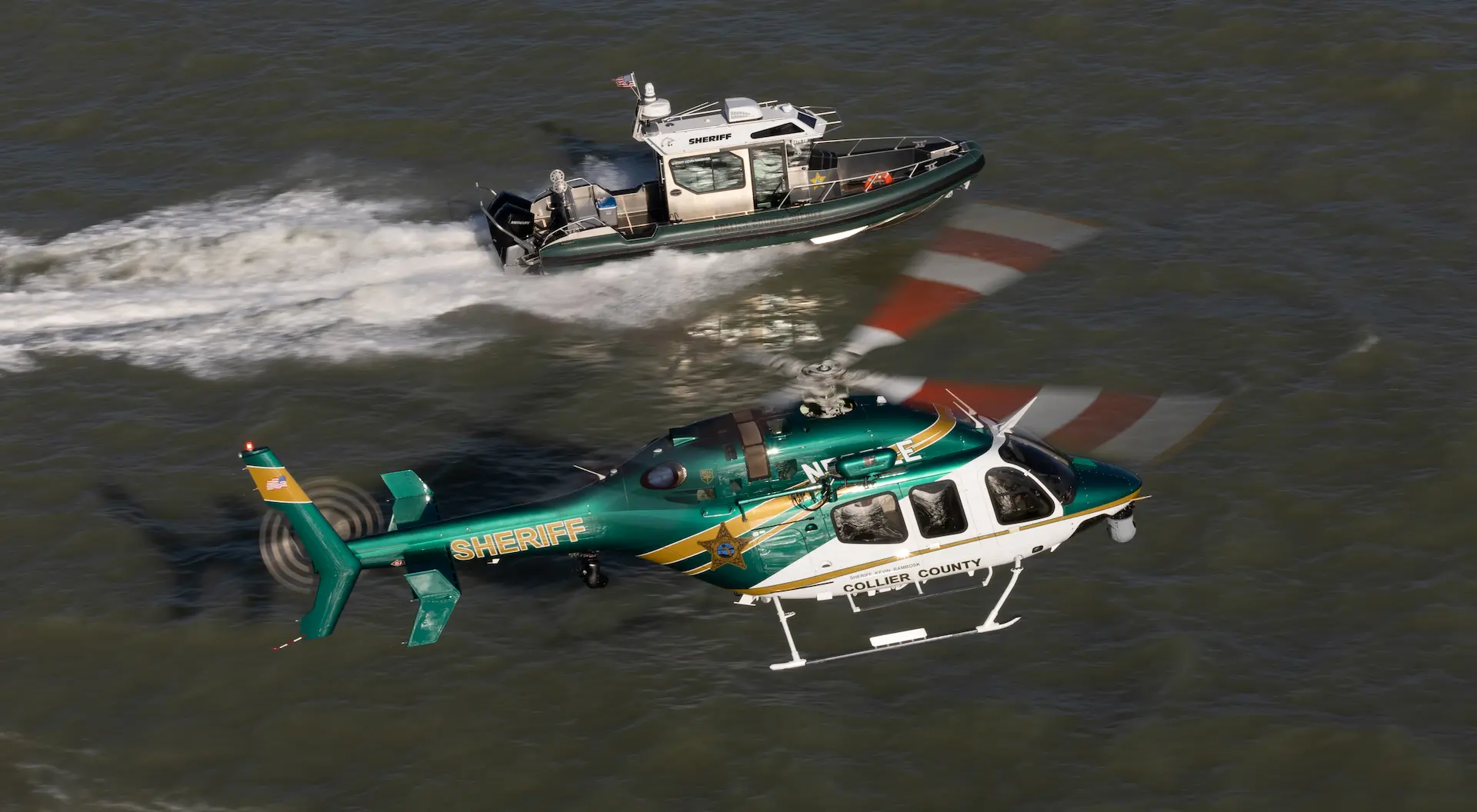
True Asset
“Our Aviation Unit is an invaluable asset to keeping Collier County safe, and our citizens recognize that,” Sheriff Rambosk said. “I often get approached in public by residents who tell me it gives them great peace of mind knowing our aircraft can help protect their home during brush fire season or locate a missing loved one in the Everglades, should they ever need us.”
The CCSO Aviation Unit started to takeoff in 2015 with the arrival of former U.S. Marine Dennis DeRienzo, now the lieutenant in charge of the unit in Naples, Florida. Prior to coming to CCSO, Lt. DeRienzo was employed as a pilot after retiring from the NYPD chief pilot’s position with 22 years of service in that department. At the time of his arrival, the Collier unit was flying patrol missions in the pair of OH58s. “At that time, we were still doing the same type of patrol missions we’d been doing since I first got here and the unit was a little stagnant,” remarked App. Lt. DeRienzo related that when he arrived, some deputies on the road actually questioned why he was appointed as a full-time pilot, as they believed that the office had disposed of its helicopters, a telling indication that the unit was not operating in the most effective and collaborative fashion with deputies on the ground. “Patrol is an important role but in today’s world it’s important that you carry out as wide a variety of missions as you can, to get the best value and return on the costs incurred in running an aviation unit,” Lt. DeRienzo opined. “We did get a new 2004 Cessna 182 fixed-wing for surveillance, which at that time involved a deputy operating on board with a pair of binoculars. It was definitely a harder way to do it, but that’s what we had back in the day.”
Next Level Of Service
On his arrival, Lt. DeRienzo noted that the local environment generates a substantial volume of outdoor activity and sports, particularly in the Everglades – which comprise around 60 to 70 percent of the county’s land area – and on the Gulf of Mexico coastline. The relatively wealthy resident population of close to 400,000 provides a solid, substantial tax base for the county, while visitors and part-time residents swell that number by hundreds of thousands from November through May, greatly increasing the prevalence of outdoor incidents and accidents. Lt. DeRienzo recalled being dispatched on one occasion to locate some lost hikers and, upon locating them, being unable to recover or aid them due the inaccessibility of the terrain and a complete lack of landing zones in close proximity. “We had to sit there, watching and waiting for either a Coast Guard helo’ or Miami-Dade fire-rescue to come into our county from the east coast and carry out the rescue.”
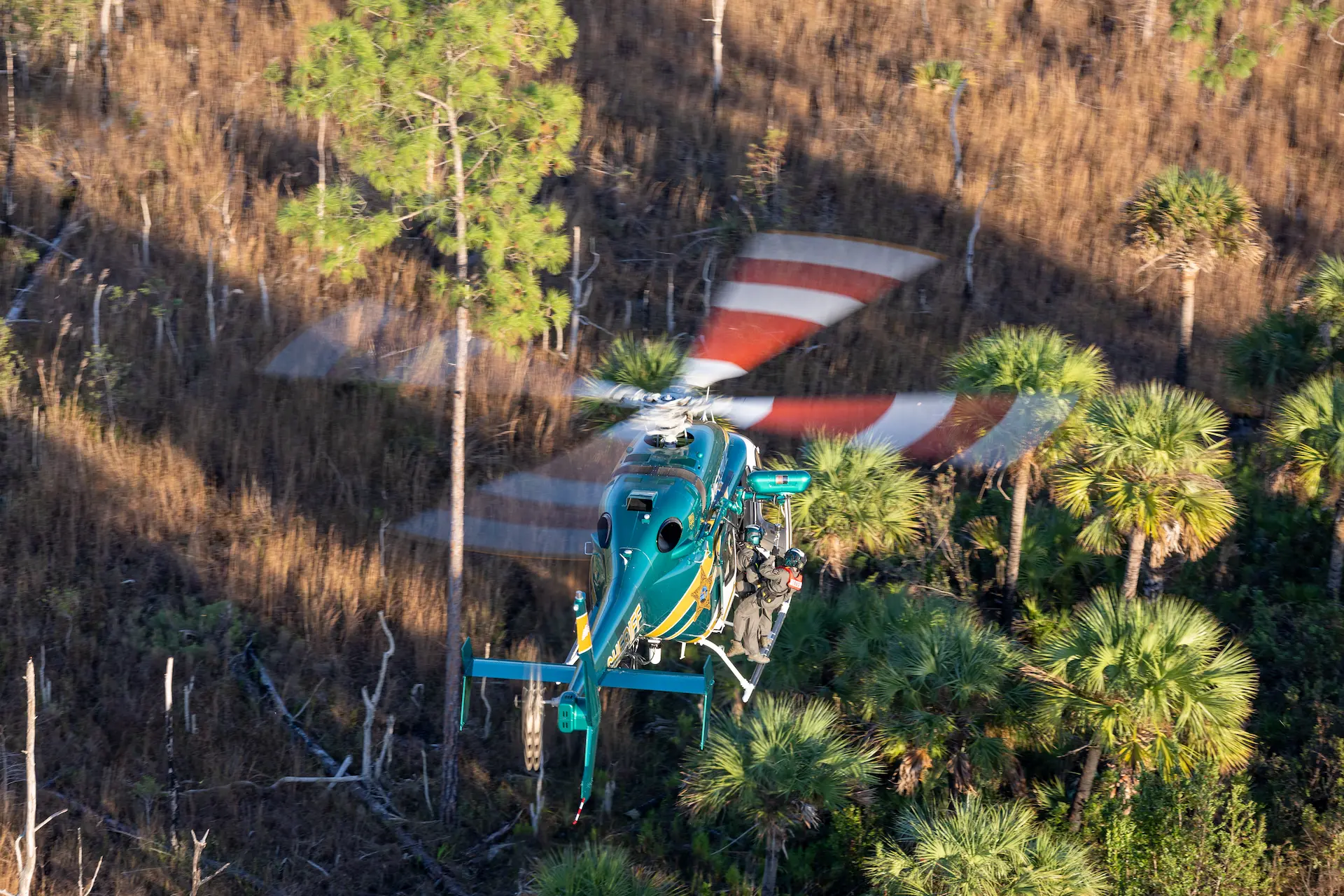
Sheriff Rambosk recognized the agency needed the capability of its own to carry out such rescue missions in order to provide the next level of service to the citizens of Collier County. Adding a helicopter to the agency’s fleet had been in the plans for several years, but a new or used aircraft would cost $6.5 million. Sheriff Rambosk decided to be proactive and move forward with the purchase of a rescue and firefighting helicopter after the agency was offered a surplus helicopter at a good price. So, in 2017 a 1968 Bell UH-1H Huey was introduced to the CCSO fleet.
Serving Veterans
After its military service in Vietnam, the Huey had been operated by the FBI, the U.S. Border Patrol and finally flew with the U.S. Customs and Border Protection Air and Marine Operations office before the CCSO bought it. It was refurbished and modified with new floors, paint scheme, cargo hook and rescue hoist, and the total cost including aircrew training came in at only around U.S. $750,000, negligible for such a large and capable machine. “It was just fortunate that it came up for sale,” Lt. DeRienzo said. After the Huey had been in CCSO service for about two and a half years, Lakeland’s Gulf Coast Avionics upgraded the original ‘steam-driven’ analogue gauges to a modern glass cockpit, which Lt. DeRienzo reported made a huge difference when operating in the bad weather that is frequently encountered on rescue missions.
The Huey went into service just a short time after the devastation caused by Hurricane Irma, so it had little chance to immediately demonstrate its capabilities in the rescue role. The intense 2018 fire season, however, provided many opportunities to showcase the big machine’s significant value as a firefighting asset. “When the residents, the county executives, the heads of the Sheriff’s Office, the fire departments and State Forestry; when they saw the capabilities that we can provide and deploy at a fire scene, there was not a single bad write-up or sour review of anything that we are doing. The strongest promotional push is from our hierarchy. Sheriff Rambosk, an elected official, really does share with the community everything he can about the services we provide and all the things we actually do,” Lt. DeRienzo commented. He is the only unit pilot with firefighting experience and went on to explain that the Huey operates on fires with a Bambi-bucket on a 25-foot longline. Longer lines are unnecessary in the county’s relatively canyon-free terrain and the short line simplifies training and operation for pilots new to the firefighting role, while remaining far more affordable than outfitting the aircraft with an onboard or underbelly firefighting tank system.
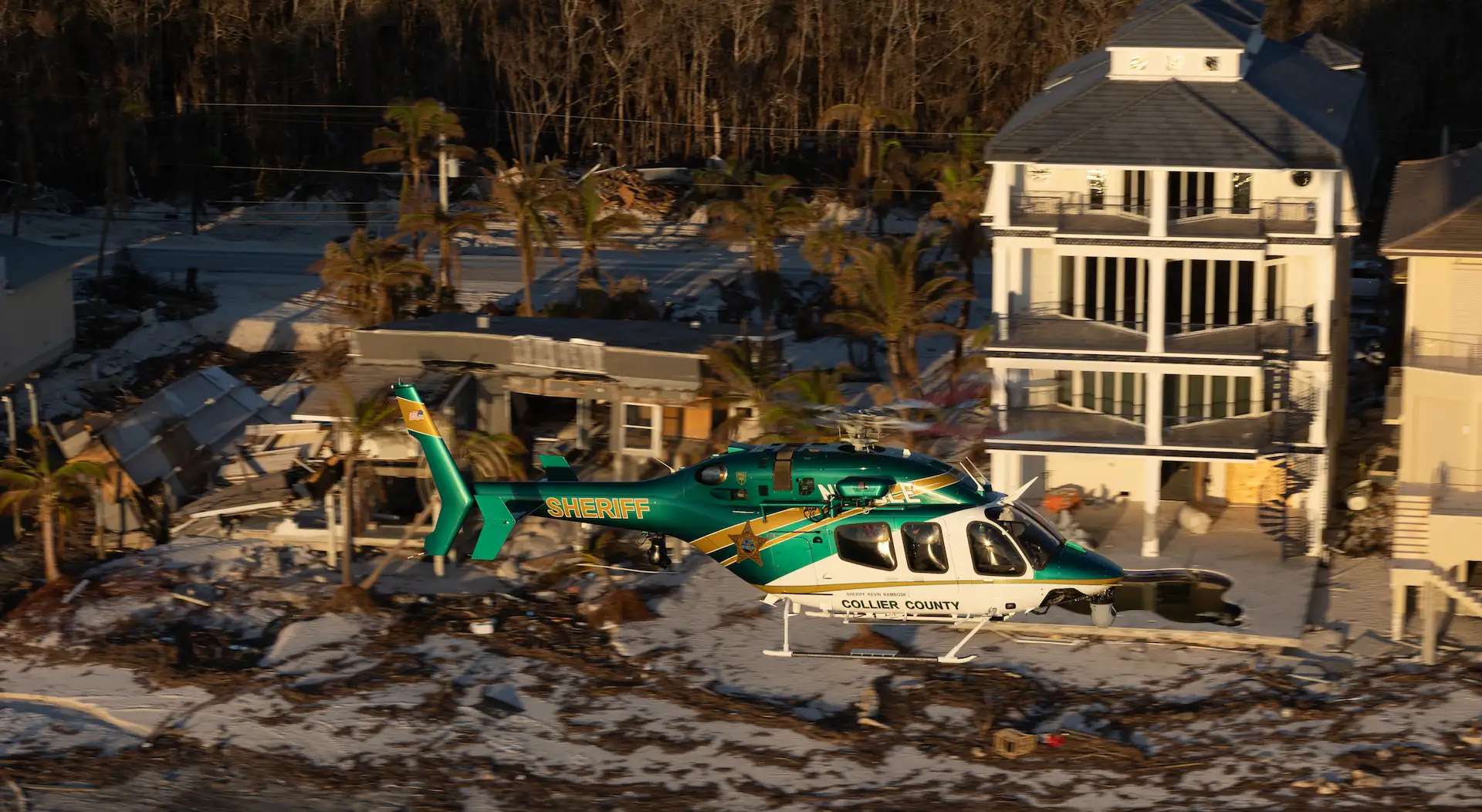
While the Kiowas fulfill the patrol mission, the Huey is dedicated to firefighting, rescue and tactical/fast-roping operations. The air unit’s focus is on helping the county, its citizenry, and its agencies, so initial firefighting efforts were conducted to aid the county’s various firefighting departments. Recognition of the success of those early sorties quickly established the CCSO Huey as a major firefighting asset. It was followed by eventual State Forestry accreditation as an approved and deployable asset, with pilots all carded for operation under State Forestry control. Although the state agency operates its own air asset, the state-wide nature of its operation means that its own aircraft may be engaged elsewhere in the event of a Collier County fire, so Lt. DeRienzo noted the importance of having the Huey available to tackle fires within the county at short notice.
Firefight
Firefighting usage is high, as a normal fire season starts in late February/early March, after what is typically about four months of very dry weather and Lt. DeRienzo tells that fires are then frequent, and often large and extremely fierce due to the oily nature of much of the fuel source. “While we were fighting one particular fire and pulling water from a canal, we watched it ignite the opposite side of the canal purely from the radiated heat. I was amazed at how many thousand acres burn, and a lot of it is in populated areas now that they’re spreading right up to and into the Everglades,” he commented. “It gets so bad that Forestry comes in with their assets from all around the country, even tanked airliners, and what is amazing is how fast the fuel regrows and comes back. As an example, we had a huge fire in 2018 and then the very same area burned again two years later as if it hadn’t been burned in 10 years!”
Once the Huey was operational, Lt. DeRienzo immediately faced another battle: Finding pilots to fill slots vacated by retirements. “You can’t get young people to invest all that money in flying, to make not much money working nights, weekends and holidays on all our law enforcement missions,” he acknowledged. “A perfect example of that was Hurricane Ian last year when we had to set our families up to fend for themselves so we could set up here and stay at work. This job is, and always has been a calling so I had a real challenge on my hands to find pilots.” He reported that at one stage the unit was down to just two pilots for the fixed wing and three helicopters, and related, “I suggested then that we trained from within, as I did in the NYPD. We had a TFO program, and I could see from flying with them that we already had deputies with the capabilities, the drive and the passion to be a law enforcement pilot. You can’t just have civilians flying this mission. You have to have people in these aircraft who know what the deputies on the ground are doing, what they need and what they’re going to do next.” Lt. DeRienzo also likes applicants for pilot training to prove they have appropriate desire and commitment, or ‘skin in the game’, by paying for at least their own fixed-wing PPL flight training.
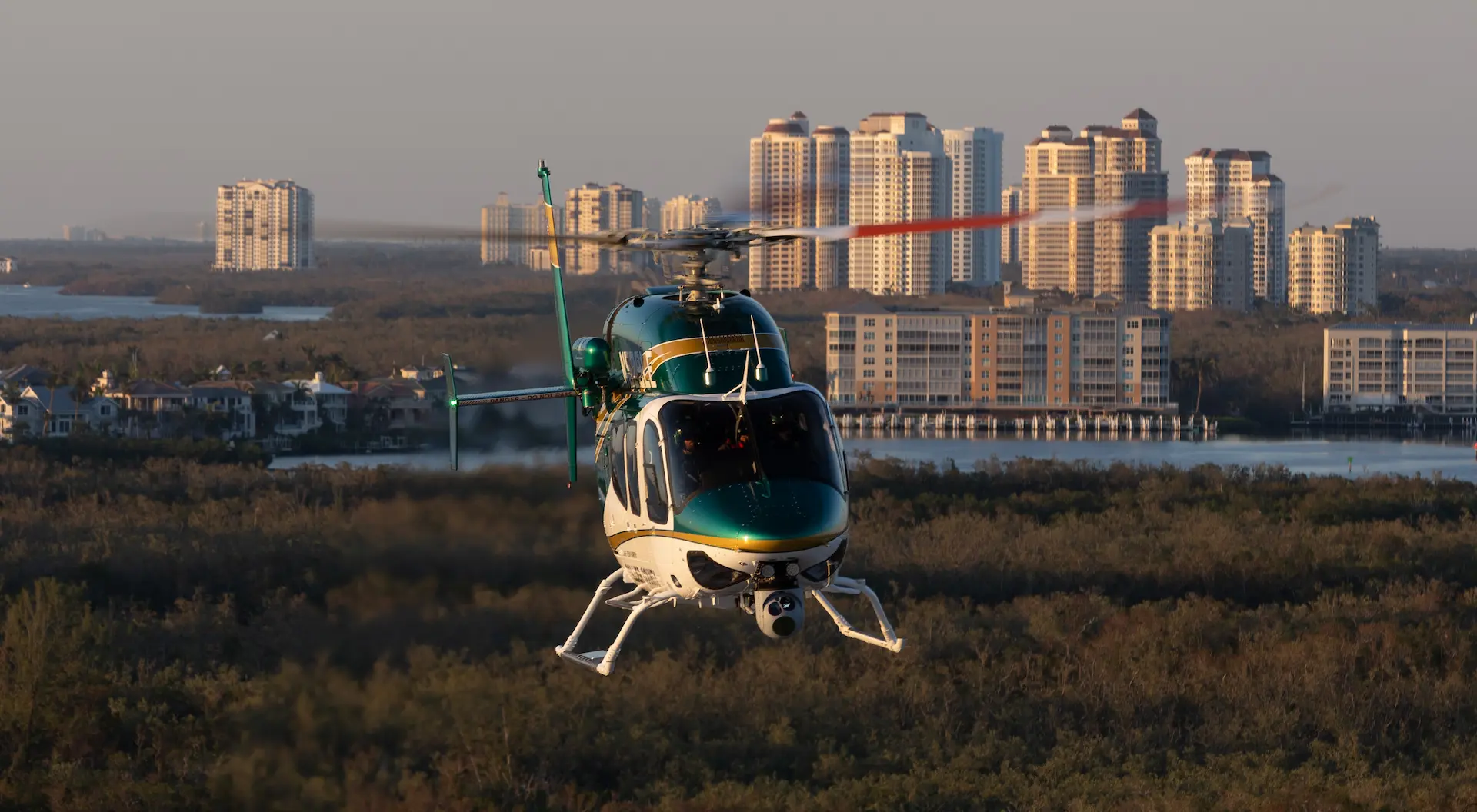
Training
According to Lt. DeRienzo, there was initial reluctance centered on the extra risk incurred in conducting such a training-from-within initiative, but he pointed out that risk was inherent in all CCSO mission training, whether it be for firearms, K-9, motorcycle or mounted units. “Everything has risks but I knew we could do it and I started training from within the TFO program, starting with Aaron App and then with Josh White, a TFO alternate from the marine division. Now, both of them are trained and checked out in everything we fly and every mission we do, and I’ve just recently started with Matt Macera from SWAT, who was on both our TFO and rescue programs. With the arrival of another qualified pilot from Nashville, Tennessee, I now have four full-time pilots plus me, and I’ve got Matt in pilot training,” he advised, going on to explain that attrition from retirements had also impacted on the pool of available TFOs, with just six deputies on the TFO roster at the end of 2022. Three full-time mechanics carry out the unit’s in-house maintenance, with ex-marine Mike in the director of maintenance’s position, Andy coming from the civilian world maintaining civil helicopters in the Caribbean, and the newest mechanic, Will, from an Army background. Although Lt. DeRienzo would like to see at least 10n qualified TFOs, he reported that staffing and recruitment levels are at a low ebb throughout the law enforcement world, making it difficult to affect any increase. A situation exacerbated by the high cost of living in the county and relatively meager law enforcement pay scales. The CCSO air unit runs a 24-hour operation and night flights tend to be predominantly in support of ground patrol units, while day operations are commonly inter-unit cooperation surveillance flights, burglar alarms and missing person searches.
A big part of upskilling the unit has been the adoption of the ‘competent in all positions’ principle for the unit’s pilots. Lt. DeRienzo explained that all pilots now know that they will be required to train and check out in all four aircrew positions. Alongside the pilot and TFO roles, possible rear crew positions include the crew chief – referred to as the systems operator (SO) – and the rescue specialist (RS). Despite a bad back, even 51-year-old DeRienzo is checked out in all positions. He stressed, “To attain that culture that we need, it’s important that I lead from the front so as well as being the unit commander and pilot, I’m checked out as a TFO, an SO and an RS.” While this level of multi-position training is a rarity in law enforcement, Lt. DeRienzo pointed out that operating in the TFO and rear crew positions gave pilots a far greater understanding of how best to fly and operate in the pilot’s seat, to best assist the other crewmembers in effectively fulfilling their roles. “They don’t learn that in the front, they learn more from the back when the pilot is making their job harder. So, when we do our training, it’s 10 days straight and we’re working hard the whole time, but I never see anyone slacking and by the end, everyone is refreshed and current in all crew positions. We do spend a lot of money on training but, as you know, if you don’t in this industry, then sooner or later somebody gets injured or even killed.”

A New Bell
The latest enhancement to the CCSO fleet and its capabilities is the addition in May 2022 of a new twin-engine Bell 429. Lt. DeRienzo outlined the rationale behind its purchase, stating, “The members here put a lot of faith in me that this program was safe, and that we could do it without undue risk. I knew though, that in a single-engine 1969 Huey it was only a matter of time until we encountered a problem. The engines, airframes and technology were all old, so I pushed to get us into a safer environment.” Then, just eight minutes into an equipment test flight, Lt. DeRienzo had a governor failure in the OH58 he was flying and was compelled to do a full autorotation onto the Naples High School football field. “Luckily for me, the school day had just ended so no-one was yet out on the field. No one was hurt and the aircraft was undamaged, but it really opened my eyes to the inherent drawbacks of operating older, single-engine aircraft. You can’t land in a lot of places we operate, so the only way to make it safer is to have twin engines.”
The new aircraft was envisaged as being capable of both patrol and SAR missions, an effective bridge between the patrol-only Kiowas and the special-mission-specific Huey. “We were prepared to look at other types, including Sikorskys, Agustas and Airbus’ H135 or H145, considering such aspects as cost-per-flying-hour, customer support, parts availability and inventory cost, safety, training needs, reliability, technology, and speed. To get to people on the ground where and when we’re needed, I need to make this county small and the only way to do that is to have the speed to get where we need to be quickly,” related Lt. DeRienzo. Its dual-mission suitability and high cruise speeds were therefore key factors in determining the 429 to be the best fit for the intended roles, but Lt. DeRienzo added that other supporting factors were his prior experience with the 429 and its proven capabilities during his time in the NYPD, along with the support, parts, and training benefits of operating a single-make fleet and CCSO’s long-standing relationship with Bell Helicopters. The CCSO was also able to use the on-record procurement and bidding processes from other agencies to prove that the subsequent contract process was fiscally and procedurally sound.
North Texas-based AeroBrigham carried out the CCSO airframe completion in conjunction with CNC Technologies for the systems fit-out and integration. Lt. DeRienzo had encountered CNC’s work at NYPD and as he was working to a budget, the California company was a much more affordable option for systems integration than Bell. CNC had also worked on the unit’s existing aircraft, so using them for the new machine ensured that all its equipment worked effectively and interacted seamlessly with the older machines and ground infrastructure. The 429’s fit-out includes a custom interior, a sophisticated microwave down link with military grade encryption, Technisonic radios, a Wescam MX15 thermal imager with integrated Churchill augmented reality mapping system, Meeker nose, and tail mounts, a Trakka TLX search light and an AEM (Eagle) digital audio system. Subject to bandwidth availability, the CCSO downlink system will be expanded to the point where every supervisor will be able to access the command-and-control output live. Prior to delivery to AeroBrigham, Bell Helicopter fitted a hoist, a cargo hook, and the sliding and rear clamshell doors. The new machine has its own Bambi-bucket – slightly smaller than that for the Huey – and will join the larger aircraft on firefighting missions. App considers the 429 to be a great LEA platform and commented that its newer camera system made surveillance missions much easier, also praising the aircraft’s altitude performance and high transit speeds, and saying, “We’re able to respond to scenes in a much timelier manner, whereas in the OH58 we’d watch patrol cars on the ground pass us.”
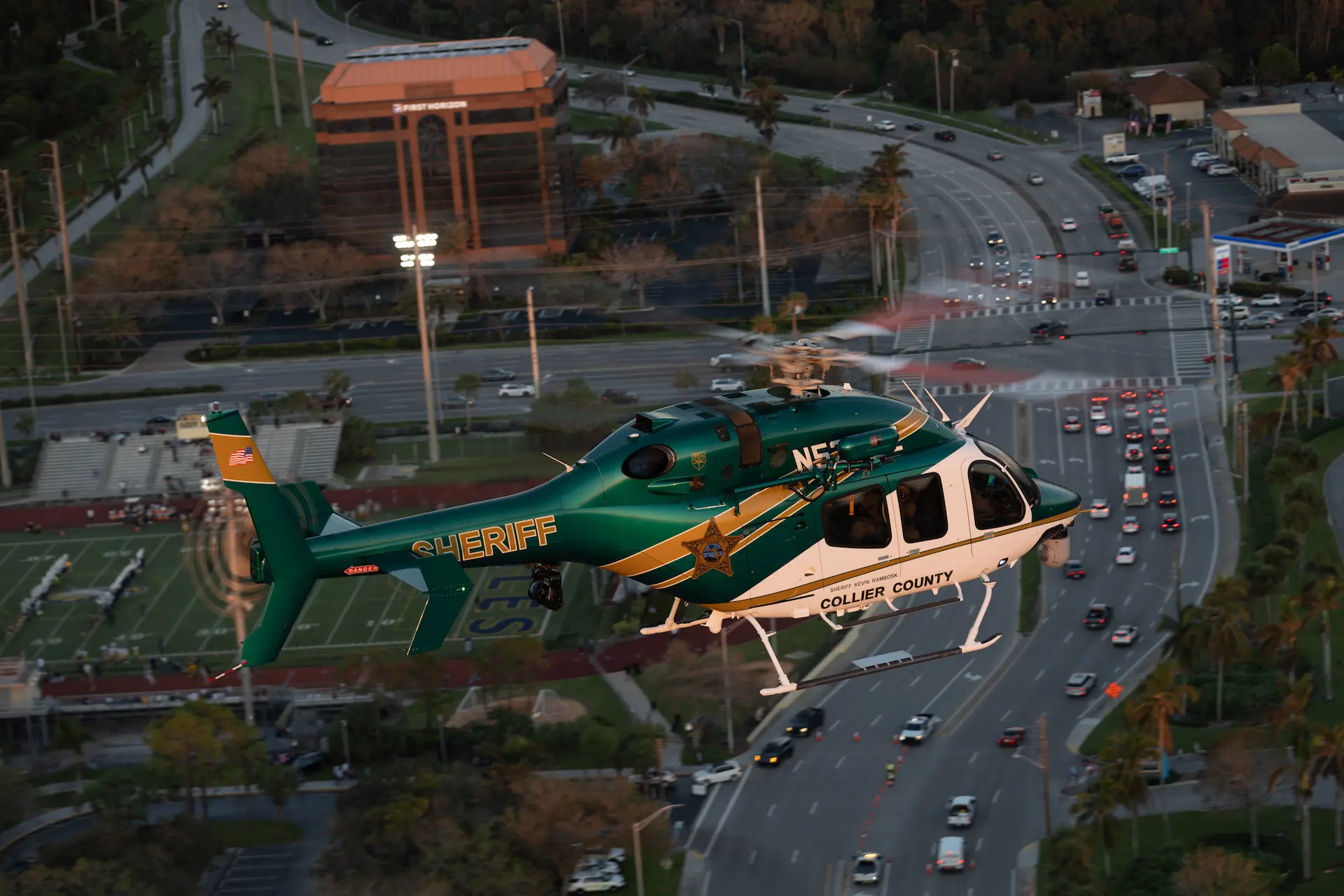
Missions
CCSO’s patrol missions are flown with a pilot and TFO – usually at or above 1,000 feet AGL to minimize noise footprint and give more reaction time in the event of an aircraft failure, while specialist missions such a firefighting and tactical are typically flown with a standard crew of two pilots up front and a crew chief in the rear, and rescue missions add one or two rescue specialists in the back. The TFO flies in the left front seat, positioned to enhance crew coordination and assist in such pilot-oriented tasks as instrumentation monitoring and lookout. CCSO also has a special working relationship with North Collier Fire Rescue District, under which a team of 10 firefighters have successfully competed to be trained and included in the aviation unit’s rescue program as qualified rescue specialists. “Whenever we have a victim, they go down and assess. They know how to use all our gear, whether it’s a streamer suit, PEP bags, backboards, or a basket. As you know, people on the ground at the end of the cable can take the helicopter down quickly, so you can’t rely on anybody that isn’t thoroughly trained,” Lt. DeRienzo elaborated. “They’re on duty at their station and if there’s a call, they’re lights and sirens to get here, which only takes five to 10 minutes.”
As is usual in law enforcement aviation, CCSO air missions vary widely from day to day, and Lt. DeRienzo admitted that to him, that was one of the most attractive aspects of his job. “It’s why I’m in this industry; every day is a different day. Some days we’ll have to set up for surveillance on a search warrant, or it might be surveillance for our vice or narcotics units. I’ve found that a lot of people come here to try to get away with crime, so we get a lot of that type of surveillance. Then there’s a lot of backing up of our patrol units on everything from traffic stops to shootings and vehicle pursuits, of which there are a lot, but everyone here knows that our main job is supporting the deputies on the road and when out on proactive patrol we respond to and monitor every traffic stop, at least until another deputy gets there. Because we’re stuck between Miami and Tampa, there is a huge volume of traffic on the I-75 highway and many people come here to commit grand theft auto and break-ins for burglaries of high-end items, so we do get a very high number of vehicle pursuits. We also help protect our coastline from human and drug smuggling, and there are a lot of elderly here so there are a lot of missing person calls for lost, confused, or disorientated people.” Macera advised that the unit works extensively with other CCSO specialist operational groups, particularly the Marine, Agriculture and SWAT units, while state agencies the unit cooperates with include the U.S. Fish and Wildlife Conservation Commission, U.S. Coast Guard, Florida Highway Patrol, Florida Division of Forestry, and U.S. Department of Homeland Security.
Integrated Technology

The technology incorporated in CCSO’s Real-Time Operations Center (ROC) ties in with the agency’s cameras and license plate readers to ensure the Sheriff’s Office can effectively combat Naples becoming another high-crime center like Chicago or New York. It’s all part of Sheriff Rambosk’s commitment to making use of law enforcement technology to prevent and solve criminal activity in the community. “I think people come to areas where they believe that law enforcement is not prepared, so they hit smaller and rural areas because they think those small law enforcement agencies won’t have the capability and technology to combat them,” Lt. DeRienzo said. “By Florida standards though, this is a large agency.” The culture relating to the Aviation Unit has evolved under Sheriff Rambosk. Lt. DeRienzo has played a key role in that evolution. There used to be apprehension about calling for air support without approval from the field lieutenant. “Now, everyone on the road knows we’re usually up and we’re such a force multiplier, so they’ll ask for us if they think the helicopter can add any element of assistance or support,” he said.
An Experience with Ian
Category-4 Hurricane Ian hit Florida in September 2022 and the air unit was heavily impacted by the storm, which was verging on Category 5. Unit personnel had to temporarily relocate to the Cat 5-rated unit facility and the whole Naples Municipal Airport was flooded, with water a foot and a half deep throughout the hangar’s floor area. “It was too late for us to relocate the aircraft, but we were lucky,” DeRienzo recounted. “We had a 7- or 8-foot storm surge here and we wouldn’t have been so lucky if it had been any more. The hangar doors were closed, and we could see how much more water was outside, but it wasn’t all getting in here.” He added that meanwhile, spec-ops units were operating from the facility in airboats and swamp buggies. As the floodwater receded, air unit personnel then concentrated on saturating all their flood-wet equipment with fresh water. At first light on the morning after the storm passed, the unit got airborne and began assessing damage within the county.
According to Lt. DeRienzo, the damage around Collier County was less than that suffered during Hurricane Irma, although neighboring Lee County was harder hit. “It was mainly the flooding and power outages that affected us, and we didn’t do nearly as many rescues as I expected, with most of our residents evacuated by buggy or airboat. And when the storm surge started to go down, we didn’t lose structures and infrastructure the same way Lee County did.” After that initial assessment, the unit transitioned to crime prevention, focusing on night patrols in areas without power that are typically targets for opportunistic looters and thieves. “I think because we got straight onto that, we hit it hard and fast enough to discourage them and they went somewhere else,” he concluded.
Reason for Being
App started in law enforcement in San Diego when he left the Marines, but decided California was not for him and applied for jobs in Florida, which he sees as a better place to raise a family. He was successful with the CCSO and cited firefighting and rescue as some of the most satisfying aspects of his current job as a CCSO air unit pilot, with around 1,700 hours logged. “I think everyone in law enforcement starts out wanting to change the world for the better. At a time like now after a natural disaster though, we’re just trying to keep bad people from doing bad things, and being able to play hide-and-seek from a helicopter is a great gig. I never thought I’d end up getting into rescue and firefighting when I started out, but once you start making saves and putting fires out between houses, you know you’re really helping people and that’s a pretty good feeling.”
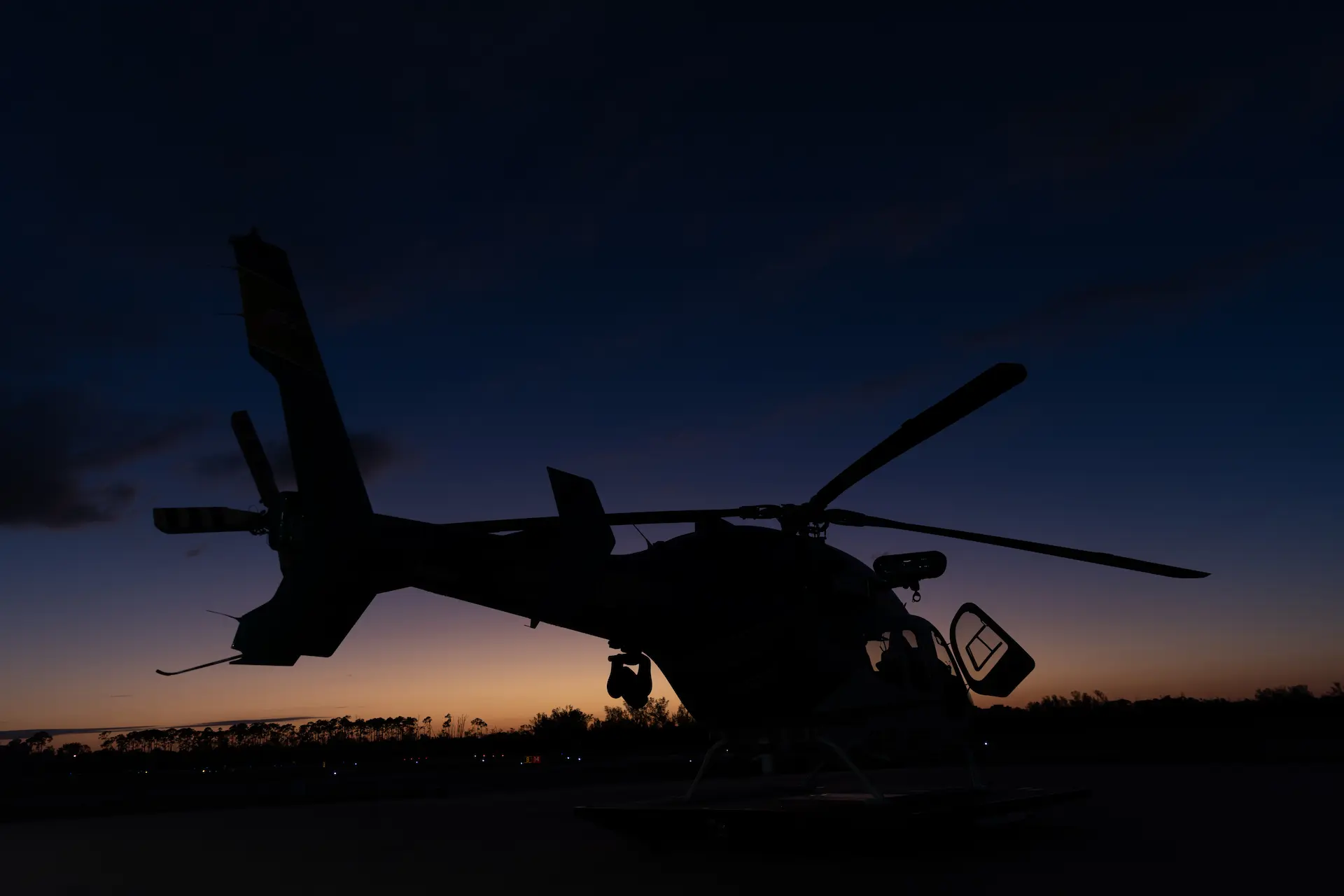
The CCSO is Macera’s first law enforcement job. He echoed App’s sentiment, noting that helping people through rescues and firefighting is a different form of helping than patrol officers on the ground experienced. When you can see that you’re physically and emotionally helping someone, pulling them out of the Everglades or putting out a fire by their home, that’s a big thing for everyone here and when you see those people later, they’re so thankful,” he stressed. Lt. DeRienzo, App, and Macera all acknowledged that their part of Florida has not succumbed to the increasing trend to denigrate, defund, and work against policing. “We live in a great area, with a great Sheriff and a great Governor, and the residents here are virtually all very appreciative of what we do, and they actually like us,” stated App. “I understand that this is a calling and when I’m doing my job, I don’t worry about that loud minority of anti-police de-funders, because I also understand that although the silent majority may not voice their positive opinions, there are plenty of people out there who need us and want us to be there.”
Looking to the future, Lt. DeRienzo would like to see another twin-engine helicopter in the fleet, as the OH58s are retired. “I don’t think I’ll be able to get a new big rescue aircraft, but I think that with two 429s, we could do everything we need to and do it well. Considering the age of those older machines, I’d hope to see another one here in the next three to five years,” he concluded.
 HOME
HOME


